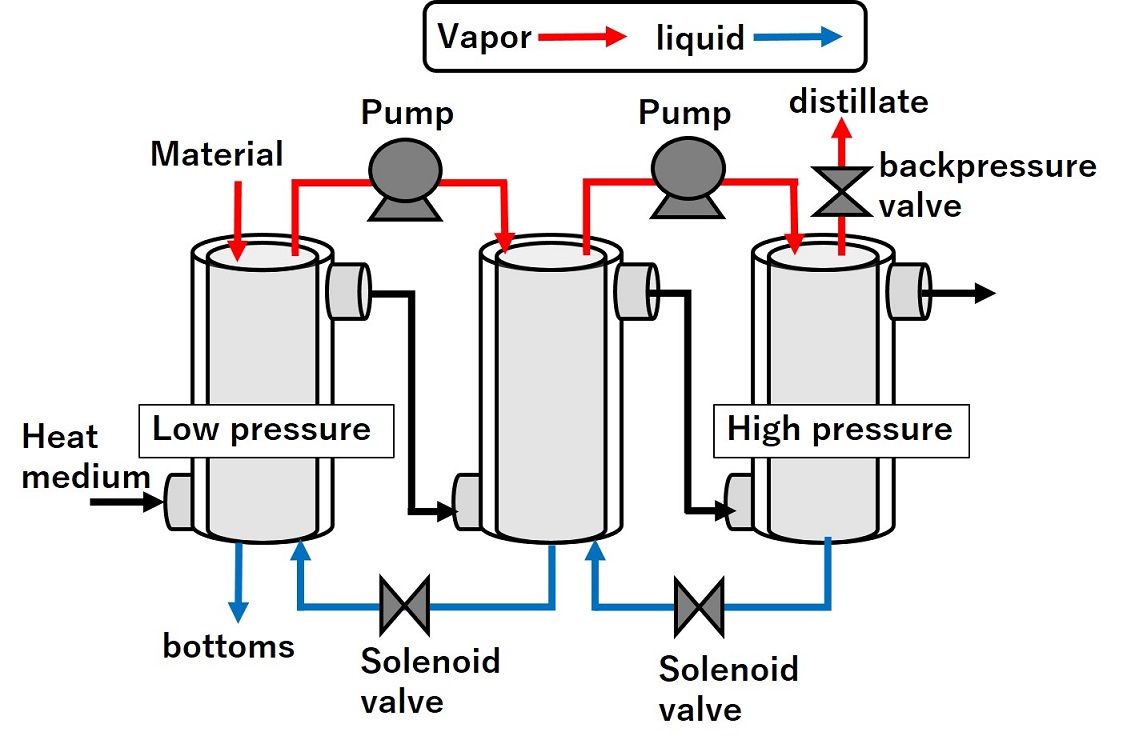
The modern process industry is required to provide high-grade products with higher yield and low production costs. However, defects are always occurring due to variations during manufacturing process. Thus, it is crucial to predict the occurrence of defects in real time. However, regression methods such as multiple linear regression (MLE) and partial least squares (PLS) are not adequate to describe the defect count data, because they assume that the number of defects (response variable) follows a normal distribution and may yield negative estimates. When the response variable is binary or count data, generalized linear model (GLM) is widely used. GLM assumes that the predictor variables and the response variable have a linear relationship through a link function. Hence, GLM can cope with binary or count data but cannot cope with strong nonlinearity and multicollinearity. Partial least squares generalized linear regression (PLS-GLR) was proposed to overcome multicollinearity, and local likelihood estimation (LLE) was proposed to overcome nonlinearity. However, these GLM-based methods cannot cope with a complex system which has multicollinearity and nonlinearity at the same time. In this research, we developed partial least squares local likelihood estimation (PLS-LLE) to cope with both nonlinearity and multicollinearity by constructing a local PLS-GLR model each time when a predicted value of the response variable is required. The effectiveness of PLS-LLE was validated through a numerical example, in which the predictor variables have a linear relationship, the predictor and response variables have a nonlinear relationship, and the response variable follows a Poisson distribution. Root mean squared error (RMSE) and R-squared (R2) coefficient of determination were used as evaluation indices. Fig. 1 shows the result of repeating this simulation 50 times. It was confirmed that PLS-LLE showed higher prediction accuracy than the existing methods.
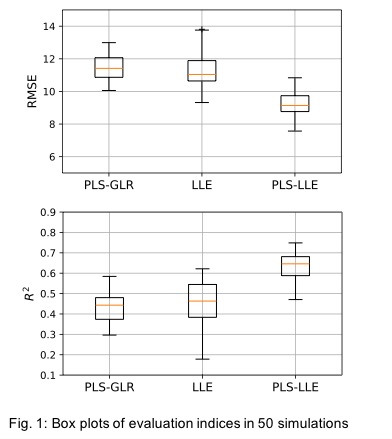
Batch or semi-batch reactors are frequently utilized for industrial-scale chemical production. Online estimation of product qualities is important for controlling the reactors. For example, if we can estimate the concentration of a product with high accuracy, termination of reaction or modification of reaction conditions can be determined accordingly. It is, nevertheless, difficult to sample products online due to extreme such reaction conditions as high temperature and pressure. Even if sampling is possible, analyzing the samples takes some time, making online estimation difficult.
In this study, we propose a scheme for building data-driven or soft-sensor models for solving this issue. Our goal is to time-series predict a product quality (objective variable) from online monitored process variables by a soft-sensor model with high accuracy. The soft sensor model can be built on the process variable data and a product quality data, which is usually measured a few data per batch, i.e. final product quality. Therefore, constructing robust models as well as identification of the Domain of Applicability (AD) is crucial for time-series prediction. Process variable values far from those of final products must be handled property.
Our proposed scheme consists of two methods: in order to make the AD of a soft-sensor model wider, artificial samples with pseudo objective variable values are generated (1). Confidence of each predicted value can be represented by variance of the value using Gaussian Process (GP) (2).
As a case study, we conducted time-series prediction of Melt Flow Rate (MFR) of a semi-batch process plant by using a soft-sensor model. Predictability of the proposed scheme was evaluated by comparing modeling methods, whether or not incorporation of pseudo data. As a result, the error in the high MFR region where the density of data points was scarce was greatly reduced, and predictive ability improved at the same time.
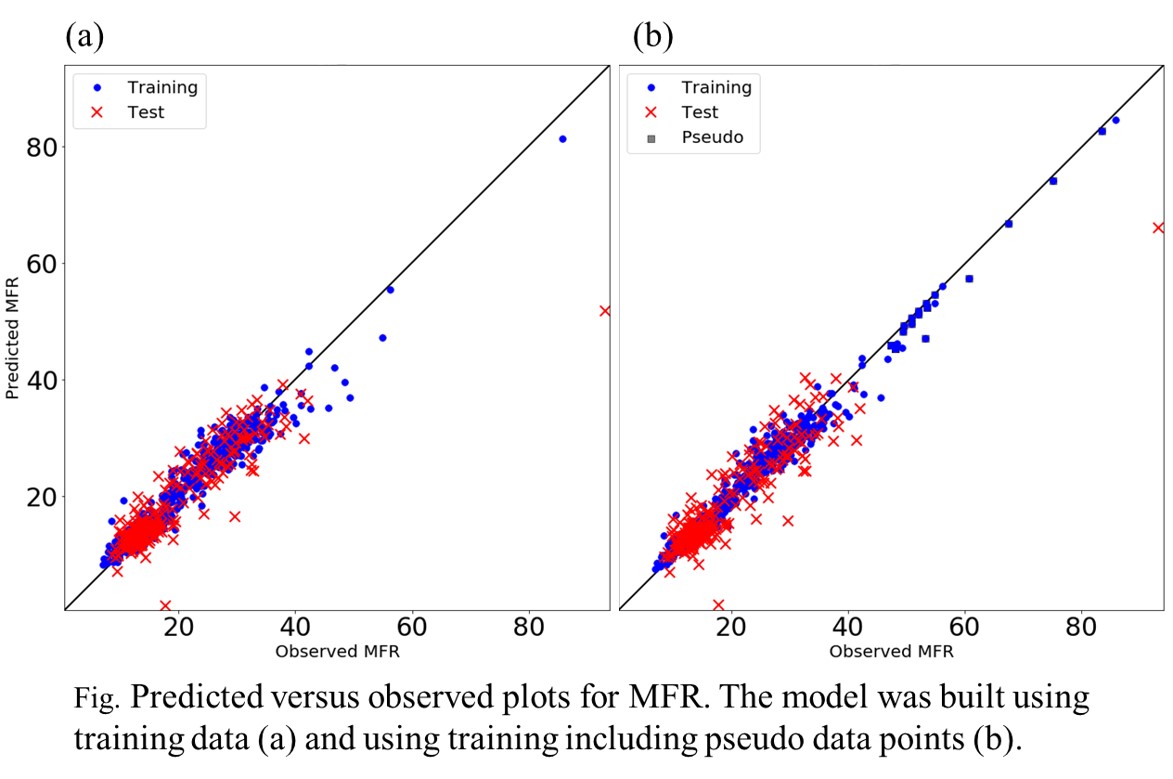
Utilizing hydrogen as an energy carrier is one of important technologies in order to make effective use of renewable energy. The use of hydrogen carriers is expected to transport and store hydrogen in a long-term and stable manner. At Fukushima Renewable Energy Institute, AIST (FREA), research is being conducted to use organic hydride (methylcyclohexane) as a hydrogen energy carrier. Since renewable energy such as solar power generation and wind power generation involves short- and long-term fluctuations, methods to suppress fluctuations of electric power with a battery and hydrogen flow rate by a buffer tank are required. From the viewpoint of cost, however, it is important to reduce the amount of such additional equipment. Therefore, in this study, we examined methylcyclohexane production by a fixed-bed catalytic reactor using hydrogen generated by alkaline water electrolysis with renewable electricity. A control method to supply toluene depending on input electric power to the electrolyzer was developed based on the data obtained under steady state conditions. The method was applied to a hydrogen energy carrier production system operated by using triangular waveforms and renewable energy waveforms. As a result, hydrogen produced from simulated power of PV panels is effectively stored as methylcyclohexane.
Hexamethylene diisocyanate (HDI) is an important raw material in the polyurethane production. Traditionally, the HDI synthesis route involves extremely toxic phosgene as an industrial scale reagent. Recently, thermal decomposition of hexamethylene-1,6-dicarbamate (HDC) has been considered as the most attractive non-phosgene process for the HDI synthesis because HDC can be synthesized by the reaction of 1,6-hexanediamine and the green reagent dimethyl carbonate (DMC). Therefore, synthesis of the intermediate HDC is crucial to the whole process and receives much attention. In this study, three strategies are proposed to design the separation processes in HDC synthesis. Reaction products are fed into a series of distillation columns for separation. These design strategies fall into two categories. Strategies 1 and 2 belong to the first category where DMC and MeOH, which can form a minimum-boiling homogeneous azeotrope, are almost entirely withdrawn from the first column top. Strategy 3 belongs to the second category where some amount of DMC is specially obtained from the first column bottom. Excess reactant ratio of DMC to HDA is adopted between 4 and 8 as suggested from literatures. External heat integration and internal heat integration are utilized to decrease energy consumption. Simulation results show that the processes designed by strategy 3 require the least total annual cost and much economic benefit is achieved through internal and external heat integrations under different excess reactant ratios. The key cost saving from internal heat integration is attributed to the full utilization of DMC-methanol azeotrope characteristic at high pressure, and the higher overhead temperature allowing condenser duty to be released to column bottom.
Palm kernel shell (PKS) is one of the byproducts generated from palm oil mills when fresh fruit bunches are converted into crude palm oil (CPO). Due to the increased production of CPO, PKS increased proportionally. PKS is currently used as fuel source in biomass boilers for heat and power generation. Malaysia, world's second largest producer of palm oil, generates significant amount of PKS annually. For 2018, about 6 million tons of PKS was produced in Malaysia. In view of this, Japanese companies have shown increased interest to utilize PKS as a fuel source to reduce carbon dioxide emissions in nation's power generation industry. As a result, large amounts of PKS have been exported from Malaysia to Japan for power generation. However, with increasing demand on PKS for power generation, it is imperative to evaluate the inherent vulnerability and sustainability of such supply chain. Currently, no documented information available on actual properties of such biomass for international trading and its supply chains between Malaysia and Japan. In addition, it is important to shape supply chains considering alternative technologies and implementation strategies, such as industrial symbiosis. Therefore, the objective of this study is to understand the feasibility and vulnerability of supply chains consisting of export routes for PKS from Malaysia to biomass-derived power plants in Japan. To achieve the objective, life cycle of the supply chain is evaluated based on carbon dioxide emissions. Cradle-to-grave information on palm oil production in Malaysia and exporting mechanism of PKS to Japan are first gathered. Inventory data are obtained from Malaysian palm oil production processes. For supplementary/missing data, ecoinvent and IDEA databases, as well as published articles on palm oil mill production processes are used. Outcomes of this study will contribute heavily towards important decision-making on optimizing the supply chain of PKS between Malaysia and Japan.
Yeast extract (YE) frequently used for bioprocesses, and the compositions were varied in the dependence of the suppliers. The difference of YE compositions often affect on the cell yields in bioprocesses. We focused on evaluation model by a metabolomics approach using non-targeted analysis and statistical calculation. In this study, it was investigated that a statistical models to predict the growth of Escherichia coli from YE component composition as an experimental model of bioprocess. The components of yeast extract were extracted from media containing varying concentrations of yeast extract and analyzed using gas chromatography-mass spectrometer. The yeast extract was categorized into three clades by principal component analysis (PCA). The E. coli growth using yeast extract showed approximately 30% difference at equivalent amount of supplementation. The bacterial growth in the media was estimated for the component profiles by partial least squares regression analysis (PLS-R). A predictive model was developed from the relationship between bacterial growth (as subjective attributes) and component profiles (as objective attributes), and correlation coefficients were calculated. Most of the amino acids in the media stimulated growth; however, methionine had negative effect on growth. In a culture validation, Asp, Val, Glu, and Trp stimulated the bacterial growth, but Met inhibited. The other amino acids tested, Ser, Ile, Asp, Lys, Phe, Leu, Thr, and Gly did not show significant effects on the growth. The results indicate that the metabolomics approach can provide useful feedback information to improve the cultivation.
The purpose of this research is to develop a plant factory with high energy efficiency and capable of adding value. Cultivated plants assumed in this paper are spinach. When grown in a low temperature and high humidity environment, these vegetables have added value such as improved sugar content.
In recent years, plant factories have been developed at home and abroad. However, as a problem of plant factories, much energy is consumed for light source and air conditioning to grow plants. This increases plant production costs as compared to outdoor cultivation and facility cultivation in greenhouses. Therefore, in order to reduce the room temperature rise in the plant factory due to the heat generation of the light source, appropriate temperature control is required.
In this paper, in order to investigate the energy saving reduction method of temperature in a plant factory, a facility combining root zone cooling and hanging cultivation is proposed and thermal analysis is performed. Here, in "hanging cultivation", plants are hung upside down, and water containing nutrients is sprayed to the roots for growth. And, the light for growth is emitted from the under.
Plants have been found to grow normally even at high temperatures by cooling the roots. In this study, in order to make the surroundings of the root cool in the plant factory, we analyzed the temperature change of hanging cultivation with and without the aluminum cooling plate. In addition, analysis of spray cultivation was also conducted.
As a result, the plant factory which brought up the plants by hanging cultivation and installed the cooling plate could lower the root zone more effectively. Therefore, it is assumed that this method can reduce the energy consumption of plant factory compared with other methods.
This work aims to enhance the performance of a reactor by optimizing its design parameters. For this, computational fluid dynamics (CFD) was used to analyze a multi-tubular reactor that involves an exothermic reaction. The design parameters such as baffle configuration, layout and diameter of the tubes, flowrates of feeds and coolants were considered to estimate their impacts on turbulent flow in a shell and its consequent impact on the performance of the reactor. Lastly, these parameters were optimized, and its simulation results showed higher conversion and selectivity for the desired reaction.
Acknowledgment:
This work was supported by a research project entitled “Development of Integrated Interactive Model for Subsea and Topside System to Evaluate the Process Design of Offshore Platform” funded by the Ministry of Trade, Republic of Korea (Project no. N10060099).
Due to the shortage of fossil fuel, bioethanol is a potential green fuel considered to be a sustainable alternative to petro-derived gasoline. The availability of environment-friendly and economical fuels is a worldwide priority. The raw material for bioethanol production are corn, sugar cane, wood, and carbon captured from flue gas. Though the raw materials are different, the product purity of ethanol is at most in the range of 5 to 12 mol percent. The high amount of water in the product leads to higher separation energy cost. There are a lot of methods to break azeotrope between ethanol and water. In the present works, most of the studies compare their results with only traditional industrial processes. Also, most studies do not consider dilute feed conditions. In this study, a comparison between some of the common configurations of extractive distillation, azeotropic distillation and membrane distillation with dilute feed conditions is made using Aspen Plus V10 to obtain optimum results. The results shows that in the 10 mol% ethanol-water feed condition, extractive distillation with pre-concentration distillation column can obtain the lowest total annual cost.
Transportation is a major consumer of fossil fuels and a major cause of air pollution. As an alternative fuel to gasoline to reduce greenhouse gas emissions, the development of bioethanol has received great attention. Bioethanol can be produced from saccharide raw materials, starchy raw materials and cellulosic raw materials. The latter, also known as lignocellulose, are one of the most abundant substances on the planet and are therefore considered an important material to be used to replace petrochemicals for sustainable development. In the process of bioethanol production, lignocellulose needs to be pre-treated by chemical or physical methods to degrade its constituents into monosaccharides for fermentation. The use of zinc chloride-containing ionic solution for lignocellulose hydrolysis has the advantages of high yield, short reaction time, no need for pre-treatment, and is a very promising technology. The ionic solution hydrolysis is then followed by distillation and filtration, and the glucose and salt in the hydrolysate are separated by membrane before the subsequent fermentation. This work aims to reduce the capital and operating costs for hydrolysate separation through the synthesis of an optimal membrane network, while maintaining product specifications and recovery ratios, thereby improving the economic viability of the process. A superstructure-based mathematical programming model for the membrane separation system is developed to facilitate its design and optimization, and to determine the required number of membranes, network structure and operating conditions through appropriate objective functions. A case study will be presented to illustrate the proposed approach.
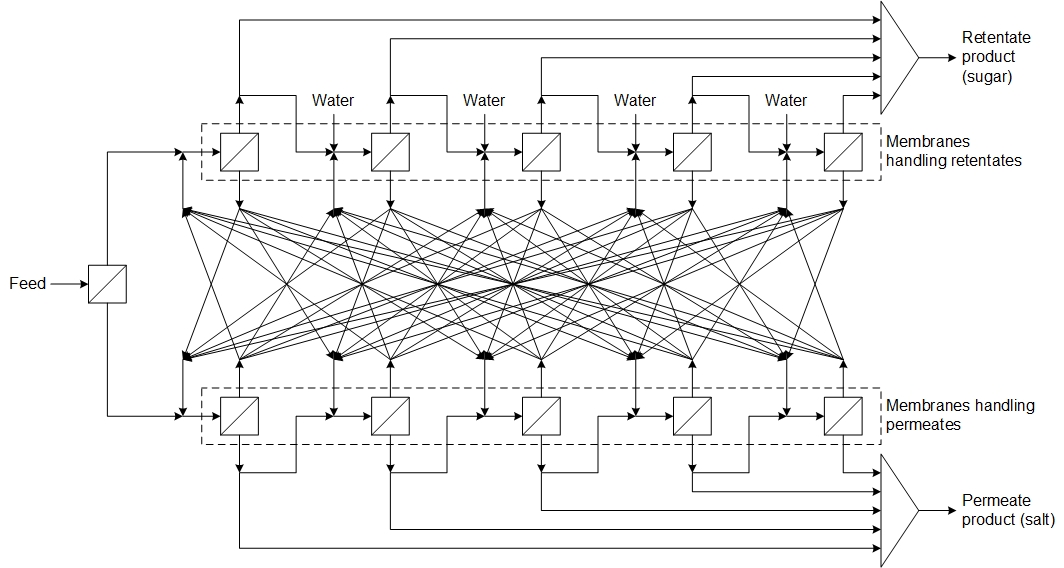
Potable water and energy are gradually insufficient for human needs. To exploit sustainable resources, technologies have been developed to desalinate seawater and produce power using salinity gradient. Reverse osmosis (RO) is one of the major technologies for desalinating seawater, while pressure retarded osmosis (PRO) is a promising technology for power production. The RO desalination plant has the problems of extensive energy consumption and brine discharge, which can be alleviated by hybridizing the RO process with the PRO process as an integrated RO/PRO system. This study is to pursue a higher goal, that is, the power generated by the PRO can provide the energy consumption required for the entire integrated system. Namely, the hybrid system can achieve stand-alone operation (without external energy supply) for seawater desalination. In this study, we conduct feasibility analysis and optimization design for the stand-alone operation of two hybrid membrane osmosis desalination systems (i.e., RO-PRO and PRO-RO systems). Based on the rigorous mathematical model of RO and PRO processes, the feasibility of stand-alone operation is analyzed, and the optimal system design and operating conditions of the hybrid systems are developed through mathematical programming by minimizing the requirement of specific total membrane area. The result shows that the PRO-RO system is a more favorable design structure for a stand-alone hybrid membrane osmosis desalination system. Furthermore, the operation of the membrane osmosis process is bound to be affected by membrane fouling. Based on the membrane fouling model, this study explores the effect of membrane fouling on system energy and water production efficiency, and proposes a dynamic adjustment strategy of operational variables to cope with the fouling effects. The optimal operating strategy is obtained by maximizing the water production while the system maintains stand-alone operation.
Optimum design of the utility system is crucial in offshore platforms that have a restriction in space and weight. The utility system mainly includes production of electrical power and treatment of cooling and heating mediums for the operation facilities in the platform. In this study, the required amounts of electrical power, total heat duty for cooling and heating were analyzed through the operation periods of gas and oil well platforms. In addition, various operation scenarios were included for the analysis. Then, the utility system was designed to meet the requirements of utility consumption. Lastly, numerical model of the utility system was optimized to minimize overall capital and operating costs, having a higher energy efficiency of the platform.
Acknowledgment:
This work was supported by a research project entitled “Development of Integrated Interactive Model for Subsea and Topside System to Evaluate the Process Design of Offshore Platform” funded by the Ministry of Trade, Republic of Korea (Project no. N10060099).
In this study, the isopropyl-acetate (IPAc) production via reactive distillation (RD) process is taken to observe the control performance with the assistant of virtual model. The artificial neural network (ANN) was trained to be the virtual model, and the Aspen Plus Dynamics was considered as the real plant. The inputs of the ANN model contain the feed flowrate of isopropyl alcohol (IPA) (FIPA), the setpoints of the temperature controllers (TC12SP, TC3SP ), and the feed composition of IPA and acetate acid (HAc) (XIPA,F, XHAc,F). Then, the corresponding outputs are the IPAc and water mole fraction in the products (XIPAc, XWater).
In reality, the catalyst activity would become smaller with time. However, the virtual model would not have the aging phenomenon if the model is built under the steady-state. At length, the model mismatches between model and process would become greater if the virtual model does not be adjusted. To this end, this study focused on the updating method for the models which are established under the steady condition .In order to maintain the product purity, the model predictive control (MPC) was utilized to control the product concentration.
The method of updating model is designed as once per day and an adaptive filter would be added. Based on the measurements, the weights and biases of the adaptive filter would be modified by least mean square (LMS) algorithm. According to the results, the on-spec products could be generated for 6 months if the model had been updated. Otherwise, the off-spec products would start to be produced after 4 months if the model were not updated.
Reference:
Lee, H. Y., Li, S. Y., Chen, C. L. Evolutional Design and Control of the Equilibrium-Limited Ethyl Acetate Process via Reactive Distillation-Pervaporation Hybrid Configuration. Ind. Eng. Chem. Res. 2016, 55, 8802-8817.
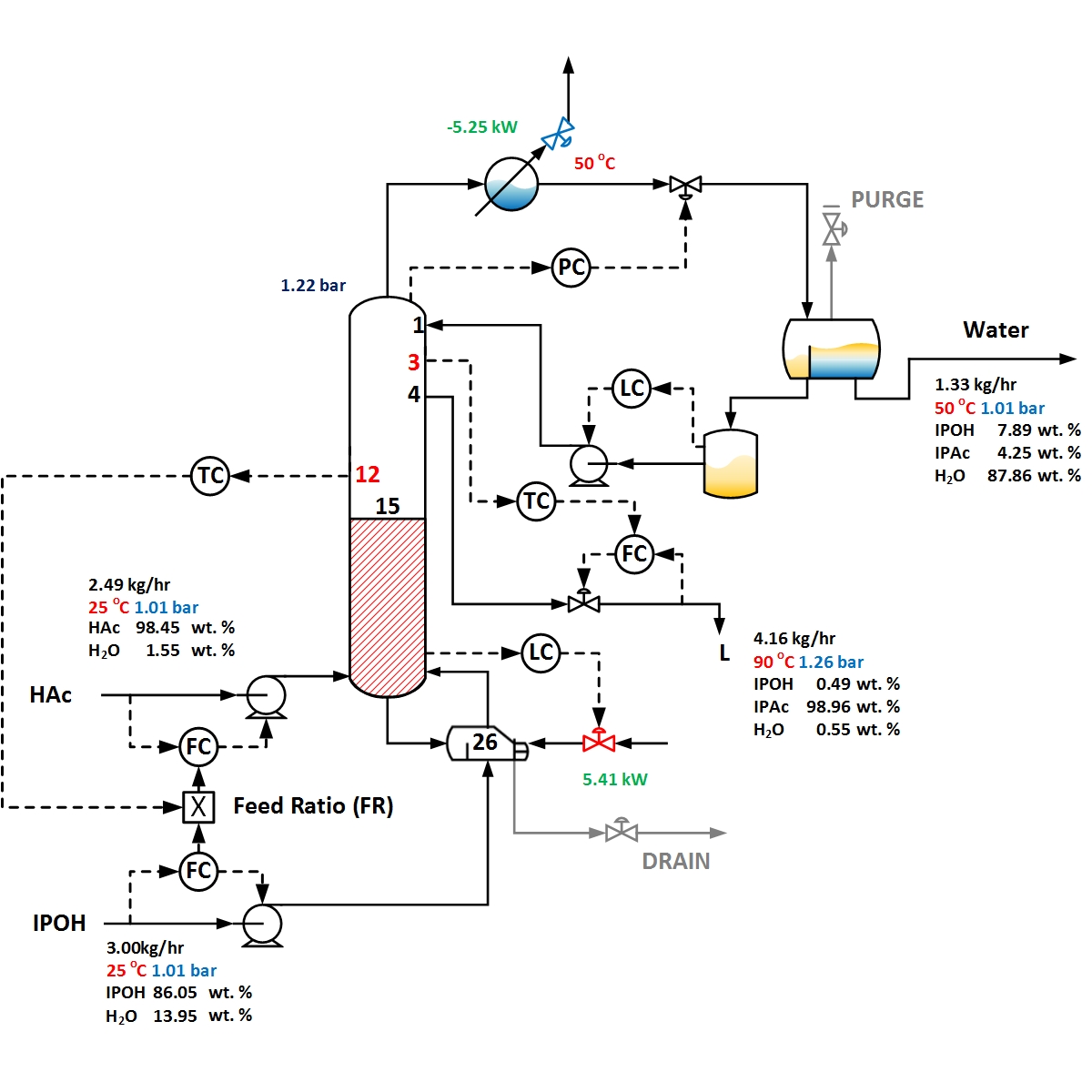
In this study, an internally heat-integrated reactive distillation column (r-HIDiC) is proposed. The silane (SLC) multi-tasking reactive distillation (RD) process is chosen as the case study. The flowsheet of the SLC production process is utilizing two RADFRAC columns from Aspen Plus V10.0 simulator. One column is operated at a high pressure (HP) and another column is in a low pressure (LP). HP column has no reboiler and it is divided into two sections, the rectifying and reactive sections. LP column has no condenser and it has a stripping section. The bottom product from HP column will be sent to the top stage of LP column. The top vapor of LP column will be recycled to the bottom stage of HP column through a compressor. The desired products will be obtained in the top stream of HP column and byproduct will be obtained in the bottom stream of LP column. An iterative optimization procedure is applied to obtain the optimal design that have the minimum total annual cost (TAC). Later on, the multi-tasking reactive non-HIDiC process will be assisted using the optimal results. Then, an internally heat-integration will be implemented in the process (r-HIDiC). The whole reactive section of HP column is a heat source, and the stripping section of LP column acts as a heat sink. Figure 1 shows the flowsheet of SLC multi-tasking single RD (left side) and r-HIDiC (right side) configurations, respectively. The heat required for evaporation in the stripping section is obtained from the reactive section, reducing the heat duty of the reboiler (however work is required for the compressor). From the simulation result, the SLC multi-tasking r-HIDiC configuration can achieve energy saving of up to 15% compared to the SLC multi-tasking single RD configuration.
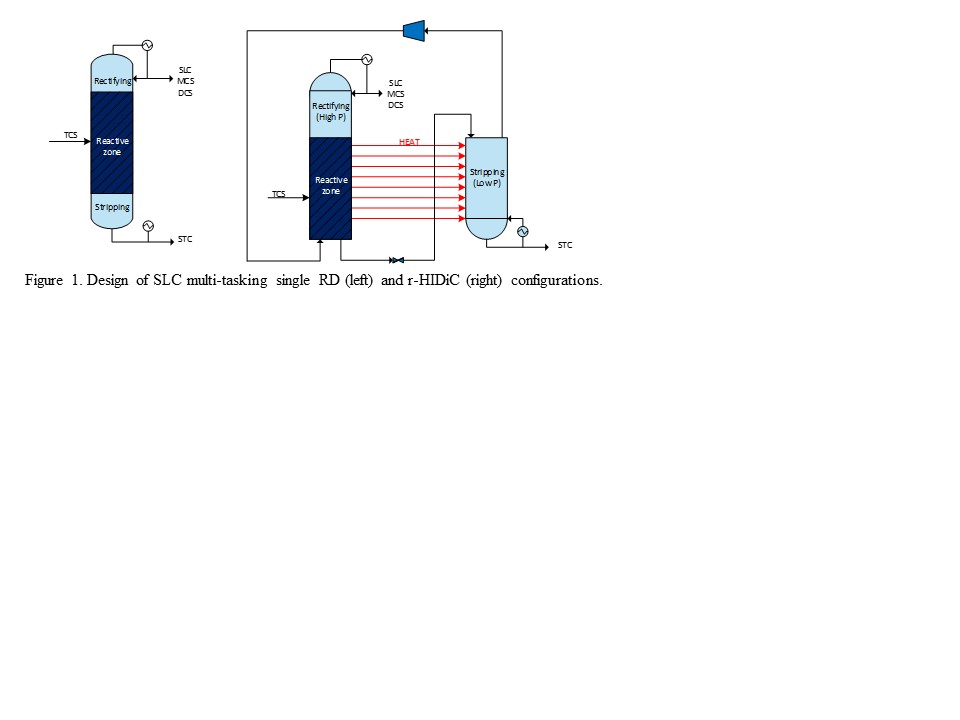
Relative humidity (RH) has shown its importance in almost every field from weather prediction to pharmaceuticals industries. The RH estimation is particularly important to maintain the product quality and to prevent the equipment from corrosion reactions. For RH estimation as a function of dry-bulb temperature and wet-bulb temperature, psychrometric chart is used which is a graphical representation of the physical and thermodynamic properties of the psychrometric processes. Nevertheless, the RH observation from psychrometric chart is not an easy task, mainly due to the high chances of human error. Therefore, the rigorous and user-friendly estimation of RH is an ongoing issue, so far. In this context, we are going to implement the state-of-the-art “Machine learning” technique to develop a simple, robust, and rigorous predictive tool for the estimation of relative humidity. The performance of the proposed machine learning-based predictive tool is validated through the psychrometric chart and also compared with previous published estimation tools. This work was supported by Basic Science Research Program through the National Research Foundation of Korea (NRF) funded by the Ministry of Education (2015R1D1A3A01015621) and by Priority Research Centers Program through the National Research Foundation of Korea (NRF) funded by the Ministry of Education (2014R1A6A1031189).
At present, HPLC / MS is used as a method of discriminating a liquid. This method is a high-precision physical-chemical analysis method that detects a specific mass from chemical components to be separated. However, these analysis methods require expensive equipment, and there is a problem that it is difficult to put them into practical use as a simplified method. Furthermore, in order to understand the chemical composition, pretreatment of the liquid sample is required.
For the above reason, in this research, without using a high-precision analysis device, a tea-based beverage is photographed using the image sensor (the camera of a smartphone), and the type is determined and classified by analyzed the image. After that, we linked the relationship with tea-based beverages and examined the possibility of classification.
In comparison results of histograms of photographed images, it was confirmed that green tea, black tea, and oolong tea can be classified by comparing histogram results indicating Blue brightness, Red brightness, and Green brightness.
Next, the number of peak elements and the peak class for Red and Blue was shown as scatter plots. As a result, according to the number of peak elements, it was confirmed that the variation was large in any sample and the classification was difficult. On the other, in the peak class, it was shown for each type of sample, and it was confirmed that it could be classified.
From the above results, it has been confirmed that classification of tea-based beverages is possible easily from images taken using a familiar high-performance image sensor such as a smartphone. In the future, we will deepen examination of methods that can classify samples more accurately, methods of discriminating unknown samples, and further studies using multivariate analysis.
We have the aim that the new environmentally harmonious industrial process to realize a sustainable society. One of the ideas that is attracting attention in chemical process development is Process Intensification(PI). PI has meant an approach aiming at a drastic improvement in process performance through new connections, high precision and compactness for each of the important components of the process. Structured catalyst would be novel tool for PI as the promotion functions of catalytic reaction, heat transfer, and fluid mixing.
In this study, Micro-Partition (MP, supplied by Nano Cube Japan Co., Ltd.) (Fig.1) was utilized as the structured catalyst. When the MP structured catalyst(MPC) would be filled into the gas-solid catalytic reactor, it is expected that reactivity will be improved because the reactants fluid is disarranged. It was suggested from computational fluid dynamics(CFD) that MPC could change the flow in unidirectional.
In the experiments of the MPCs are stacked in the same direction, it was confirmed that the bottom catalyst didn't effectively contribute to the reaction. The flow could be changed by structure of MP. It was also carried out the experiments that the direction of the MPCs was changed variously for confirming the contributions toward reactivity when designing the reactants flow voluntary. It was achieved the high reactivity when the MPCs were packed like to promote mass transfer by convection. In other words, it is possible to improve the reactivity by to finely control the fluid and to design the mass transfer in the catalytic reactor by using the structured catalyst.
Furthermore, it was observed what occurring about relationship between mass and heat transport and chemical reaction around the catalyst was analyzed in detail utilizing simulation software COMSOL Multiphysics. And it was proposed MPC packing method to maximize the reactivity based on the simulation results.
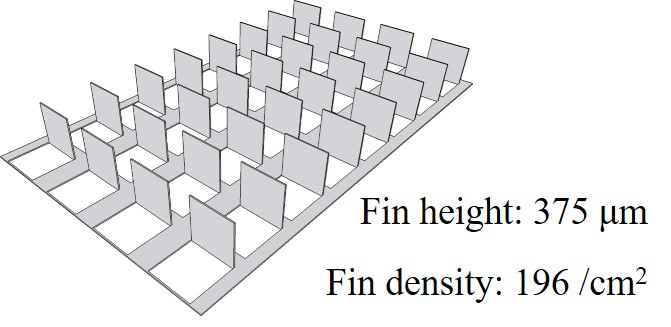
Solvent-based post-combustion carbon capture (PCC) is a mature and essential technology to solve the global warming problem. The high energy consuming issue and the flexible operation required by the power plants inquire the development of effective control systems for PCC plants. This study proposes the optimal-based control approach that utilizes optimal setpoint values for the quality controllers. The five optimal-based control schemes studied all employ L/G (liquid to gas ratio in absorber) as one quality control variable. Performance comparisons with a typical conventional control scheme are conducted employing a rate-based dynamic model for the integrated MEA (monoethanolamine) solvent PCC process developed on Aspen Custom Modeler. Compared to the typical control scheme, the optimal-based control schemes provide faster responses to the disturbance changes from the flue gas conditions and the setpoint change of the CO2 capture efficiency as well as better results in terms of IAEs (integral of absolute errors) of capture efficiency and reboiler heat duty during stabilization period. LG-Tstr and LG-Tabs-Cascade are the best schemes. In addition to L/G, these two schemes employ the control of Tstr (the temperature of a stage of stripper) and a cascade control of Tabs (the temperature of a stage of absorber)(outer loop) and Tstr (inner loop), respectively.
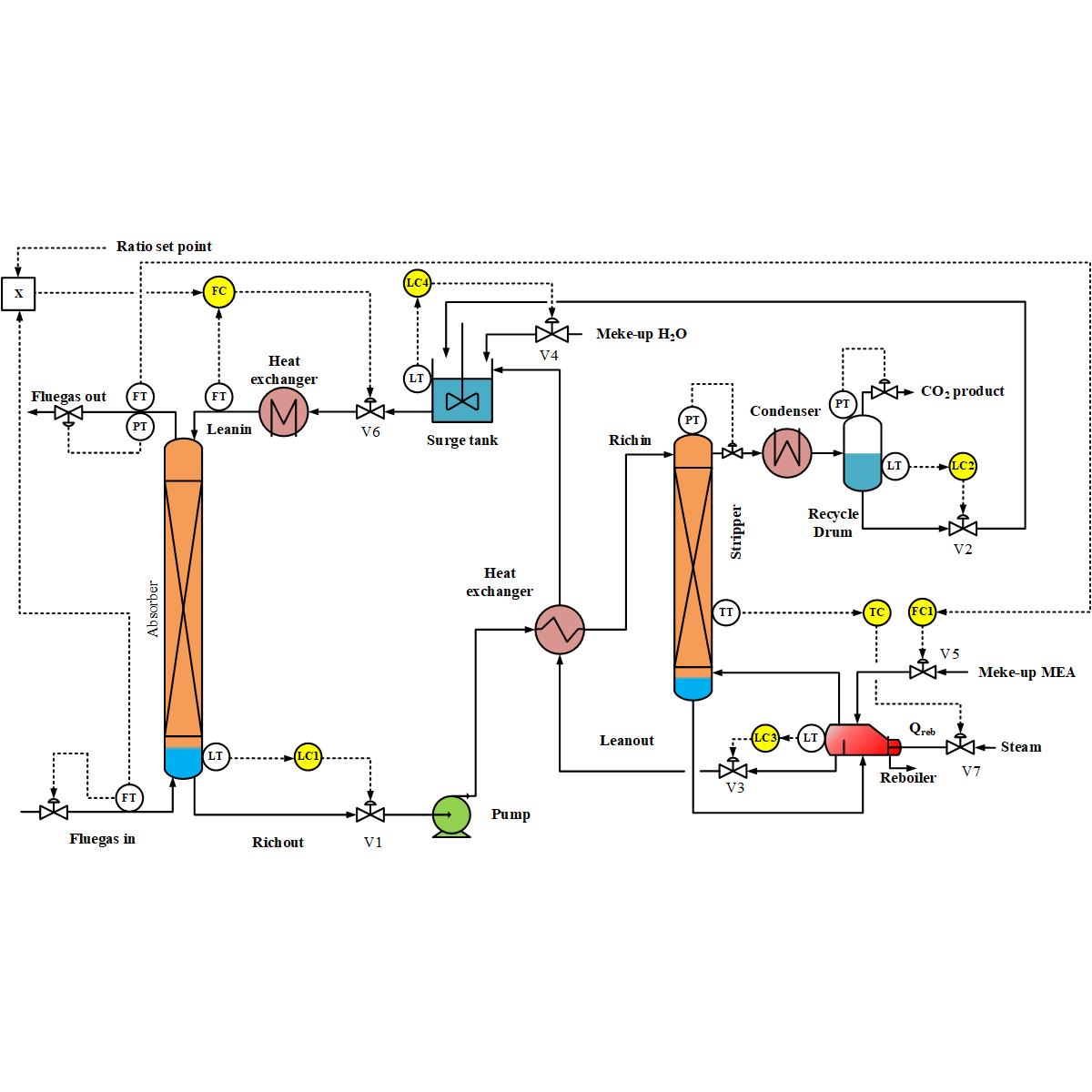
An oscillatory baffled reactor is a continuous tubular reactor with baffles arranged at equal intervals, and oscillatory flow is added to the net flow in a laminar flow region. Vortices are periodically generated in each baffle section, and mixing in the radial direction is promoted while axial dispersion is suppressed. We proposed a micro-scale oscillatory baffled reactor, μOBR, as a new tool for reaction analysis. In this study, the mixing mechanism and axial dispersion were investigated by the flow visualization and the tracer response experiment, respectively. The μOBR is the microchannel on the transparent acrylic resin plate with the size of depth 0.8 mm, width 0.8 mm, baffle width 0.4 mm, baffle distance 1.2 mm. The number of the baffles was 25 along the microchannel. In order to conduct the mixing characteristic experiment, the colored water with Rhodamine B was employed as the tracer. The flowing state in the 10th and 20th baffle spacing section in the channel were visualized by a microscope high-speed camera with the flame rate of 125 fps. The step response, F curve, was obtained from the concentration of Rhodamine B. The fitting of the response profiles with the F curve were carried out to calculate a parameter D/uL representing axial dispersion. The Reynolds number, Ren, was calculated from the net flow rate, and the oscillatory Reynolds number, Reo, was calculated from the frequency and amplitude of the oscillatory flow. The higher Ren gave the higher D/uL. It was difficult to suppress the axial dispersion because the vortices generated at the baffle wall could not grow larger and axial flow passed through the channel directly. On the other hand, the flow visualization showed that the radial mixing was enhanced and better plug flow property was obtained with the Reo increase.
State estimation of chemical processes is an important technology for controlling product quality and efficient operation. Especially, estimating difficult-to-measure values by soft sensor have been attracting attention, because it is faster and cheaper than measuring actual values.
The purpose of this study is to apply the time series data for estimating the product quality of a chemical plant. The authors focused on applying several neural network algorithms, such as Recurrent Neural Network (RNN) which enable utilization of time series data. Various algorithms, such as PCR, PLS and SVR, have been applied, however most of these methods have the disadvantage of not utilizing dynamic characteristics.
As a case study, we used a dataset from the Tennessee Eastman Challenge Process, and the concentration of a component was estimated from 33 explanatory variables. Several representations of time series data were investigated to tackle with the difference between sample intervals of the target variable and explanatory variables. Moreover, we tested various neural network architectures and traditional machine learning algorithms.
As a result, we found the superiority of neural networks compared with other algorithms. Specially, among neural networks, CNN-RNN hybrid model gives excellent results.
This hybrid model achieves much better than the traditional SVR in both R2 and RMSE, and better than the simple LSTM. We also found that it is efficient to use the samples without target data.
The results show that the proposed hybrid model provides an accurate tool to estimate process quality with the help of dynamic feature extraction by the CNN on the proposed data format.
Dealing with the unpredictable performance of a power plant has become one of the most challenging problem faced for all power plant engineers in the world. Engineers have to deal with unplanned maintenance and overhaul of power turbines resulting in a massive profit loss as it is not able to keep up the efficiency to achieve the production demand of electricity in time. To deal with the issue, production scheduling and maintenance planning are often considered and optimised independently in practice especially in power generation industry. However, conflict between production and maintenance scheduling has been an issue in managerial decision due to its interdependency. Hence, in conjunction with the advancement of Industry 4.0, a well-structure production-maintenance schedule modelled with MatLab is proposed to setup a reliable and systematic approach to deal with both maintenance and production problem. On top of that, machine configuration scheme is studied and analysed in this paper to provide an enhancement in stability and accuracy to the scheduling system. With the deployment of a P-Graph model, it provides a visually appealing interface to the users, allowing them to understand the insights of the system's decision-making principle. Optimal solutions are obtained from the model based on the load demand, allowing the system to select the best machine configuration scheme correspond to the objective of the research. This not only aimed to improve the system efficiency, also to maximise the plant profit and minimise any possible time and energy waste. It is believed that the development of the holistic package of smart scheduling smart system can be a promising breakthrough to the industry by improving the reliability, accuracy and availability of modern manufacturing system.
The global warming is serious problem in the world. Therefore, utilizing the renewable energy and low-temperature waste heat is attracted attention. Binary cycle is kind of heat engine and one of the technologies to be used a low-heat energy. Binary cycle is low power generation and thermal efficiency. Hence, improvement in power generation and efficiency are required for this technology. In order to high power generation performance, in this study cascade binary cycle utilizing separation membrane was employed.
Microreaction technology has attracted attention of chemical engineers, because microchannels show high heat and mass transfer rates. Intensification of multiphase processes, such as gas-liquid reactions and extractions, is an important application of microreactors. Slug flow is a typical flow pattern of multiphase flow in microchannels, and widely used in this field. In slug flow, gas and liquid slugs flow alternately, and a high interfacial mass transfer rate is often observed due to an extended surface area and the strong recirculation motion of fluids in each slug. Slug length is an important parameter representing the slug flow, and strongly influences the mass transfer rate, because the specific surface area and the rate of circulation decreases with increasing the slug length. Thus, to keep mass transfer rate high, it is necessary to monitor and control the slug length online. One of the typical approach to the slug length monitoring is to measure the pressure variation in the microchannel, and the periodic change in the pressure is related with the slug length.
The purpose of this research is to develop a technology to measure slug length by using AI technology. Air-water slug flow was generated in a microchannel and the slug length was varied by manipulating the flow rates of both phases. Then, photographs of slug flow with different length were taken. An artificial intelligence was trained to relate the image and the slug length by using the deep learning algorithm. With the trained AI, the slug length was successfully identified from the image of the slug flow.
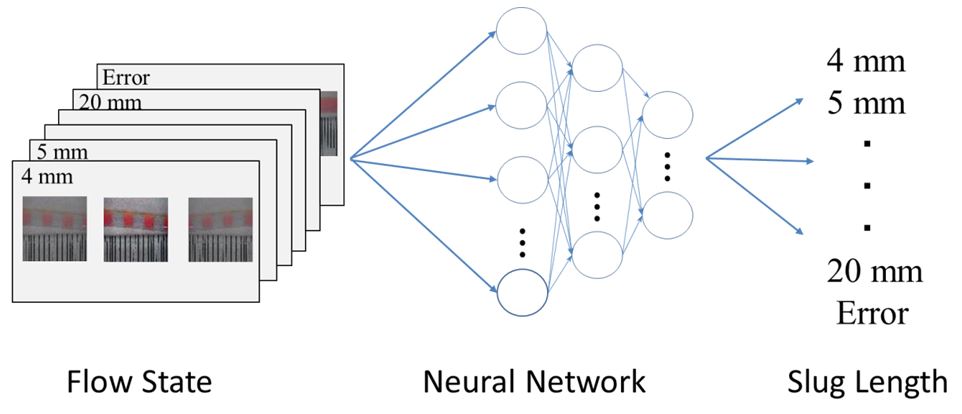
Tissue culture technique has been widely used for pharmaceutical and biomedical applications such as drug development, tissue repair, and even transplantation. However, the tissue culture process is limited due to time-consuming, labor-intensive and risk of contamination. For instance, the development of lung cells into a tissue requires periodic medium change for at least one month, allowing to proliferate and differentiate. Furthermore, standardized medicine produced using the conventional process is not suitable for personalized treatment due to compatibility and efficacy. In this work, we introduced microfluidic technology into the tissue culture process to develop a Plug-and-Play tissue culture platform which can eliminate the risk of contamination and improve the cell culture efficiency. In addition, the culture platform can be operated automatically in specific cell culture processes, such as mucus washing and air-lifting. The Plug-and-Play tissue culture platform includes a tissue card, a fluid control base, peristaltic pumps and pinch type valves controlled by a computer. This tissue card had two independent chambers separated by a microporous membrane to generate liquid-liquid interphase and air-liquid interphase cell culture environment for cell proliferation and differentiation, respectively. The Plug-and-Play culture platform mounted with miniaturized devices can simplify the tissue culture procedure for personalized application. It only requires inserting the tissue card at the beginning and removing it after finishing. The results demonstrated that the human lung cancer cells (A549) and human bronchial epithelial cells (HBEC) can be cultured in both submerged and air-lifted conditions at a dynamic flow condition for long-term cell culture. Taken together, these results conclude that the Plug-and-Play culture platform is capable of applying to diverse and complicated tissue culture procedures with a simple and easy culture process.
In recent years, in the chemical process industry, it has been performed a lot of methods in many design processes using simulation to reduce design costs. In process design of the chemical process industry, operating variables (such as the operating pressure) are determined so as to minimize target variables (eg, equipment cost). By automating this calculation process, which has conventionally been performed manually, the number of simulation steps can be significantly reduced. For that purpose, application of optimization calculation method is useful. In addition, there are multiple target variables in the chemical process industry, rather than one. Additionally, such variables are often in a trade-off relationship with each other (e.g., torque and discharge flow rate of a mixier) For this reason, in process design of the chemical process industry, application of multi-objective optimization is required rather than single-purpose optimization. Therefore, we performed optimization calculation of the mixing process in order to investigate the applicability of the multi-objective optimization method to the design of the mixing process, which is a particularly high demand process in the chemical process industry.
To find a new useful catalyst, many different catalysts must be prepared and the performance must be evaluated. Usually catalyst evaluation is conducted in a laboratory using conventional chemical apparatuses. The performance data should be collected for different temperature, flow rate and feed concentration. Since the experimental procedure is fixed, efficiency of catalyst testing is expected to increase greatly by introducing automated experimental apparatus. There are several commercial products for such purposes, but they are very expensive and thus deposition of solid substance or clogging incurs high repair cost. This study aims at development of a new catalyst evaluation system which can be built at a lower cost, and allows flexible operation. As an example of heterogeneous catalyst reaction, dehydration reaction of ethanol over alumina catalyst was used. Nitrogen gas was used as a carrier gas and the stream was equipped with a mass flow controller. The reactor was a glass tube filled with alumina power, and placed in an electric heater. The reacted gas stream was brought to a 6-way valve, which was used as an injector for a gas-chromatograph. The mass flow controller, electric heater and the 6-way valve were connected to a personal computer. The main control system was built on a Microsoft Excel, which directly send out the signals to control each devices. The spreadsheet software also records the state of the system, such as flow rates and temperature. A system capable of automatically finding the optimum conditions for this device was also incorporated to further improve the efficiency of the device. The developed system was realized at a low cost, since a popular spreadsheet software was used as the platform of the measurement system.
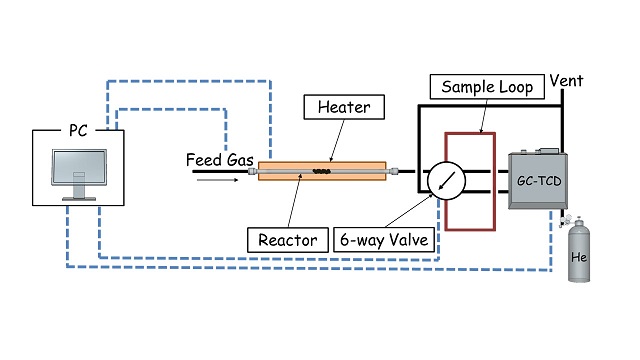
Distillation is a very popular separation technology and one of the drawback is the high energy consumption rate. To improve the energy efficiency, a variety of distillation apparatuses and processes have been proposed to date. Our group has also proposed another new distillation system, which is called Pressure Driven Distillation System (PDDS). This system is different from the conventional distillation in that the mixture is separated under isothermal condition. To gain the driving force for separation, the pressure distribution is formed. Since the system is isothermal, the heat released from the condenser can be used as a heat of evaporation at the reboiler. This thermal configuration of PDDS enables us to reduce the energy consumption rate greatly. In this study, we constructed PDDS and the separation performance was experimentally evaluated. The results showed that the vapor and liquid compositions at each stage were close to the equilibrium values, and that PDDS showed a sufficiently high separation performance.
The experimental apparatus was converted so that it allows flexible change in the configuration. For this, we built the interfaces to sensors and actuators, such as pressure sensors and valves, so that they can act as IoT devices. Through the internet connection, the measurements are sent to a database in a host computer, which can be viewed graphically on a website. It is also possible to control pumps to change the stage pressure by sending commands from the host computer. A program was built on a host computer so that solenoid valve is manipulated in the direction of decreasing the pressure, when an abrupt increase in the rate of pressure change is detected.
